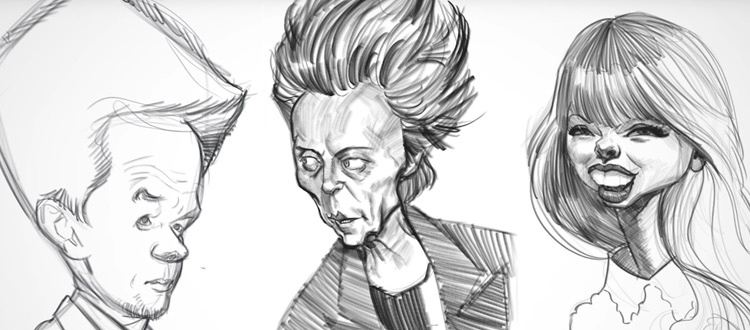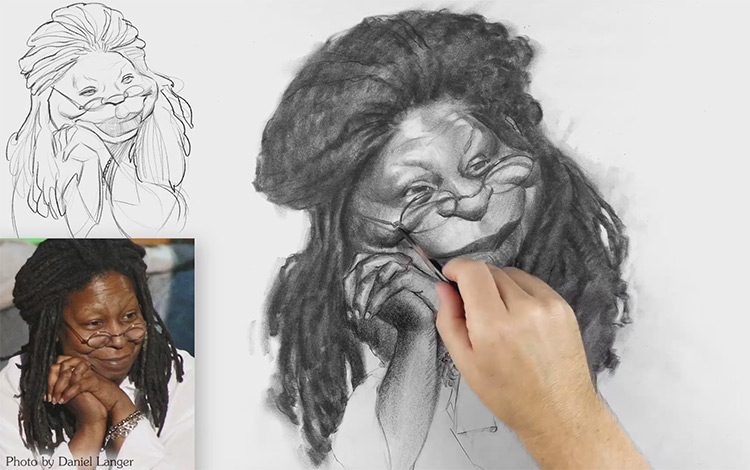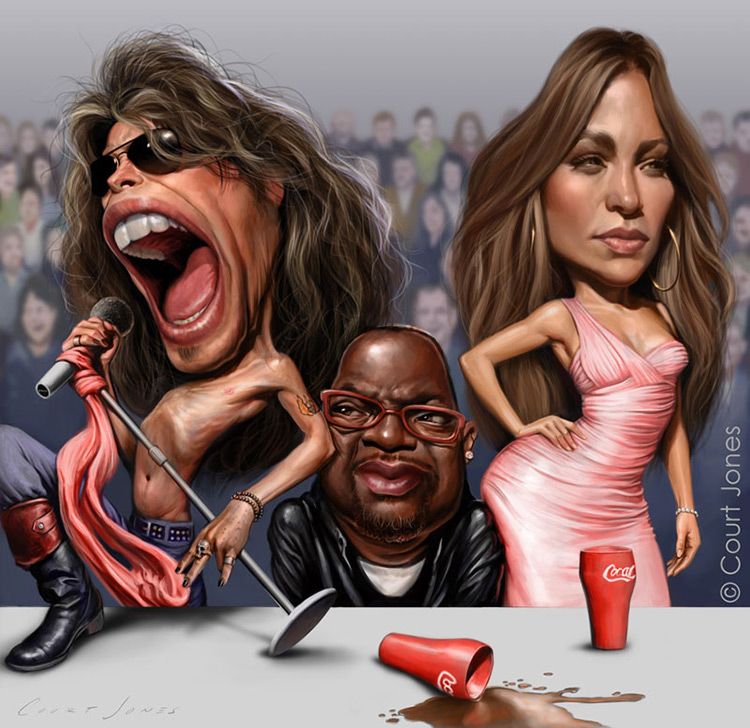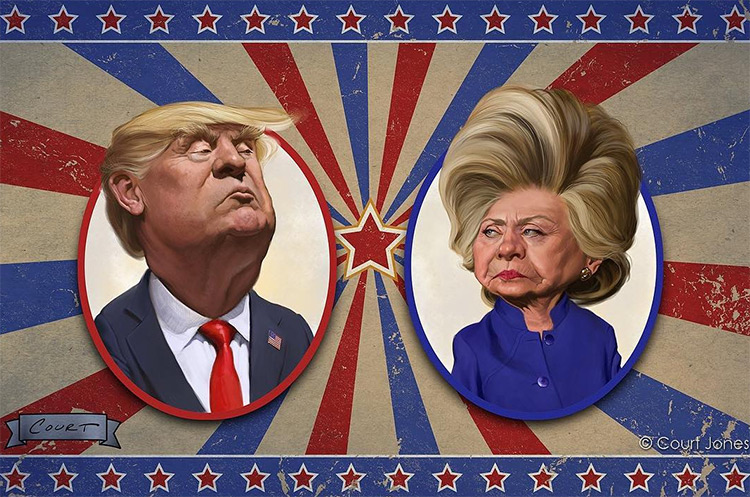Court Jones Talks Caricaturing With Advice For Aspiring Artists

Court Jones Talks Caricaturing With Advice For Aspiring Artists
Interviewsillustration Disclosure: This post may contain affiliate links. That means if yous buy something we get a small commission at no actress cost to y'all(learn more than)
Principal caricature creative person & illustrator Courtroom Jones is one skilled guy. He's got twenty+ years of experience working for major magazines like Wired and Rolling Stone, non to mention dozens of other clients & teaching gigs.
He's also won many awards including the 2011 ISCA Master Caricaturist of the Year.
Court has a knack for teaching and it shows in his new caricaturing form published by Proko. I reached out to Courtroom for more details most his grade and why it's and so valuable for all creative styles from concept fine art to realist portraiture.
If you'd like to acquire a scrap more check out his FB folio or follow Court's latest posts on Instagram @courtjonesartist.
What's your history with illustration & caricature work? When did you first get into fine art and when did you consider art every bit a viable career?
I earned an art degree from the University of California San Diego(UCSD) which had an avant garde art programme. So consequently, I had no idea what I wanted to do afterward graduation.
I got a job at a local theme park as it was the only job listing I had seen looking for "artists." It turned out to be quicksketch caricatures.
Later a few months the chore started to grow on me. I was terrible at first, like all beginning caricaturists. Merely there were really awesome artists around me to learn from, and within a twelvemonth, I began to feel somewhat comfortable doing it. Theme park caricatures don't pay much. Only it was Not bad training, and I was young, so I stuck with it.
When I got hired for private events more than regularly I began to see how you could really make real money with this art course.
So I quit the parks and focused on freelance result entertainment.
Doing only events a few hours a week freed up a lot of time for me, so I began to have classes at The Watts Atelier, where my existent education in art began. That led me to develop my skills equally a painter and illustrator.
What did yous take away from your time at UCSD and after at Watts Atelier? Were those institutions crucial to your growth every bit an creative person?
UCSD, like many other colleges and universities, had a very modernistic approach to educational activity art.
There wasn't really whatever applied grooming in how to describe or paint. Information technology was mostly virtually concepts and creating conversations with art, which isn't very useful in the real earth. But I had to accept a lot of art history courses. And those were definitely more interesting and useful than the studio classes.
I'd say what I took away from UCSD was what I didn't like about art and artists. Not to say it was a totally negative experience. Just being trained in a mod art surroundings helped crystallize my tastes and sensibilities and gave me new focus on what I valued near, which was an appreciation for more traditional artists.
When I found The Watts Atelier it was like a big shiny door had opened up to a new world I never knew was out there.
At the Atelier the teachers actually taught procedures step by step. They demonstrated and critiqued students constantly.
I learned virtually how to build a sketch in stages, how to set up different palettes, how to work with colour, how to create a potent limerick, how to ink, how to pigment, the list goes on.
After a couple years they started giving me my ain classes to teach in diverse subjects, and that'south where I retrieve I really learned how to teach and even create my ain original courses.

Do you lot think someone could teach themselves to describe/pigment merely from online resources? Or practise you think a schoolhouse is necessary to reach a professional level?
There are several models for online fine art instruction now. And they're all in their infancy compared to the brick and mortar school traditions. Then it'south hard to say which is the most efficacious.
I think all students learn differently and don't all benefit from the same blazon of instruction.
Just the nigh of import factor in growth is the student's own ambition, subject, and willingness to go over the exercises again and once again.
In my experience, the best teacher is abiding repetition & sketching from the lessons – especially when it comes to the fundamentals. And instructor feedback is definitely important to the process. Although, given the nature of online courses which sometimes take followings in the thousands, i-on-one feedback isn't always viable.
But with my class on Proko we make a critique video for every lesson.
I option several students' homework assignments from the Proko Caricature Facebook group and comment and depict over them. Premium students get access to the full critiques. And I think it's a really valuable resource for a student at home, even if I don't option their drawing to critique, considering almost all students go through the same basic struggles.
Your new caricature drawing grade on Proko is phenomenal. Where did the thought for that form originate and what encouraged you to make information technology?
Cheers!
Well, I knew Stan from the Atelier. He started there as a teenager and was educational activity past well-nigh age xx, I think.
After he left and began his online lessons in portrait and figure drawing I enjoyed following along with them at dwelling house, like and then many others. And we kept in impact during that time.
Beingness the entrepreneur he is, Stan decided to expand his offerings past teaming up with other teachers and he approached me nearly designing a caricature form.
I had been mulling over the idea to start an online course of my ain for several years and even fabricated a couple rough episodes. But I realized I didn't have the technical savvy to produce really slick videos, let alone distribute and market them.
Stan had such a solid functioning in place already and such high production values. I couldn't refuse. I actually wanted to exist a part of that enterprise.

How much effort goes into making each video similar planning lessons, recording, editing, etc?
I suspected there would be a lot of work involved, going into it. Just I didn't realize but how much it would take over my life.
It was in development for over three and a half years before we were set up to launch. Granted, I didn't work on information technology EVERY day, considering I had to balance information technology with my freelance schedule. Just at that place is but so much writing, drawing, and recording that goes into every episode.
Each episode I judge takes nearly xx-25 hours of work just on my end, when you include all the premium lessons. So Stan's large team of video production and marketing guys do their parts.
As well I put a lot of idea into the class outline as well as the private scripts to brand certain they non only are skillful stand up alone lessons, but fit into an over-arching theory on pedagogy caricature that is consequent, logical, and with a presentation style that would brand sense fifty-fifty to inexperienced artists.
I'g constantly judging myself by the quality of work Stan puts into his videos. His stuff keeps me pushing my own efforts, because I know his audience has a certain expectation of quality and thoroughness.
Feedback from Stan and his team assistance keep me on rail too.
In the first they helped me a lot with my on-camera delivery, to be more than natural. And of class when the team edits it all together with music, graphics, and effects, information technology makes me look much better than I really am on my own. And so it's definitely a result of collaboration with true professionals.
What would an creative person learn from post-obit your caricature course? And what sort of skillset is needed before starting?
Hopefully students go a good agreement of not only how to caricature, but how likeness, in full general, works.
Even in the best portraits in that location are often principles of caricature at work. So I think much of the form would be nifty for traditional portrait artists and illustrators.
I also spend time showing how I develop a raw crude idea into a polished concluding rendering. Hopefully I help de-mystify the process and show how caricature is not reliant on whatsoever inborn gift.
It'due south just most focusing and doing the work to understand the principles.
To get the most out of the grade I would hope students take at to the lowest degree some feel drawing. No formal training is necessary. Just some experience with pencil and paper and a willingness to put in some time on the subject area.
What are the biggest differences between your complimentary videos on YouTube and the premium course videos?
The free videos on YouTube have the core principles of the lessons and at least one narrated demonstration of the concept.
The longer versions in the premium course go into more detailed explanations or have an extended version of the drawing demo. Then, of course, the Premium selection also includes lots and lots of narrated demonstration videos, downloadable files, and student critique videos.
And in that location's an unabridged bonus lesson just for premium students that goes really in depth on the history, structure, and proper apply of the Reilly Abstraction.

Can your lessons assistance artists post-obit other paths like concept fine art, animation, or anything exterior of extravaganza work? How practice your lessons behave over into other fields?
I think concept art and blitheness are actually major branches of caricature.
To me, extravaganza is only the practice of purposefully controlling the blueprint of the human form. Bated from using it to raise the likeness and make people express mirth, you can also caricature someone to bring out whatever other traits.
You can use the same principles to brand a cartoon more cute, more than masculine/feminine or scarier than the original model. When concept artists and animation designers do their thing, whether they're designing a robot, zombie, or talking candlestick, they are but creating contradistinct versions of people for the purpose of telling a story.
Caricature helps artists create strong character types & insert personality into the work. This gives artists the confidence to design with more intention and humanity.
How would you ascertain "fashion" in art and what factors go into an artist'south fashion? Can your class aid artists develop their ain style?
To me "style" is the manifestation of an artist's training, influences, and materials. It's too a representation of what an artist values or sees every bit important to limited.
And because of that I strongly encourage aspiring artists to avoid learning to paint by working just digitally. Painting software is capable of literally whatsoever look or way, and gives the power to endlessly overwork over a painting without consequence.
In my opinion, artists who accept just worked digitally tend to have a very banal and sterile await to their portfolio. The brush strokes have no personality or are entirely smoothed over and by and large, colors are sampled directly from the reference photograph.
Whereas artists who learn painting in natural mediums like oils, gouache, or watercolors and with express palettes are influenced by what those mediums can exercise. And then they find artistic ways to get certain furnishings and usually develop a more than individualized colour sensibility. Once an creative person attains a certain condolement level with a traditional medium they can and so go into the figurer and bring their own uniqueness to the procedure. Their digital work volition naturally be heavily influenced by their traditional painting experience and will exist a lot more interesting to expect at.
So considering I get into so much detail showing my process, I recall information technology'due south likely that my extravaganza lessons will accept some influence on my students' individual styles in the beginning of their development – especially as information technology relates to drawing and pattern.
But as they gain more experience and report other artists they volition co-operative out and develop their own unique styles.
What sort of balance is needed between practicing realism & exaggeration? How does realist piece of work help a caricaturist/illustrator meliorate their ability to exaggerate or draw from imagination?
I'm a big believer in cross-training in art.
I think every subject area you written report helps influence and amend your work in other areas. Caricature tin help portraitists and realistic illustrators to improve upon their reference photos and insert more life or enhance a likeness when necessary.
And of form the control & bailiwick yous learn when practicing more traditional "realistic" drawing of the face and figure, the more subtlety and composure will announced in your caricature work.
In my experience, art directors at magazines really like to see realism in the extravaganza art. But I advise confronting only designing for the art directors or trying to imitate a popular mode.
Try to draw and pigment in a way that makes YOU happy and the right clients will somewhen be attracted to you lot.

What common mistakes do artists make when kickoff learning to exaggerate? Is it ever "too early" to start experimenting with exaggeration?
The ii main problems I see in people's piece of work when they first start to caricature are:
- timid portrait-like exaggerations, and on the other extreme
- uncontrolled, badly distorted sloppy caricatures
Both problems unremarkably result in weak likenesses.
For the first type, they don't spend enough fourth dimension experimenting with exaggeration choices and get stuck in the safe "portrait zone". I encourage them to put more than attempt into the thumbnail concept stage.
For the 2nd type, who draw besides sloppily, I encourage them to spend more than time refining their rough sketches using tools like the Reilly Brainchild to discover & gear up their structural errors.
But it'south never also early to start experimenting with exaggeration.
With the way I teach caricature, the beginning step is figuring out the direction of the exaggeration with quick thumbnail sketching. In the subsequent step of the rough sketch I emphasize likeness as the priority. And and then side by side is refining the construction with the Brainchild.
I'g a strong laic in breaking down a complex job into smaller more manageable steps.
What parting advice tin yous share for artists only starting on their journeying?
Be ready to practise a lot of sketching and repetition. And don't rush to acquire painting or rendering too presently.
Sketching tin can seem boring compared with painting. Merely near artists' painting problems can be traced dorsum to poor drawing fundamentals.
Just like with learning a sport or musical musical instrument, you demand to accept good fundamentals under your belt before you lot can produce loftier-quality work consistently.
The fundamental training period is when you'll develop not only your mitt just also your eye, your ability to discern practiced design from bad. In that location's no shortcut to learning that kind of thing.
Many cheers to Court for taking time to answer these questions & offer his insights into the wild earth of extravaganza.
If you take any involvement to improve your exaggeration skills and then check out Court's caricaturing grade on Proko. It'll definitely help you come across improvements no matter how long yous've been drawing or what type of art you make.
You tin also learn more virtually Court on his principal website or on his fine art portfolio. He posts a lot of piece of work on his social accounts like Facebook and Instagram if you'd like to follow there as well.
And if you wanna check out Court's gratuitous extravaganza videos you can scan this playlist from the Proko YouTube channel.
We also wrote a detailed review of Court's caricature serial if you wanna come across exactly what information technology offers.
Source: https://conceptartempire.com/court-jones-caricature-interview/
0 Response to "Court Jones Talks Caricaturing With Advice For Aspiring Artists"
Post a Comment